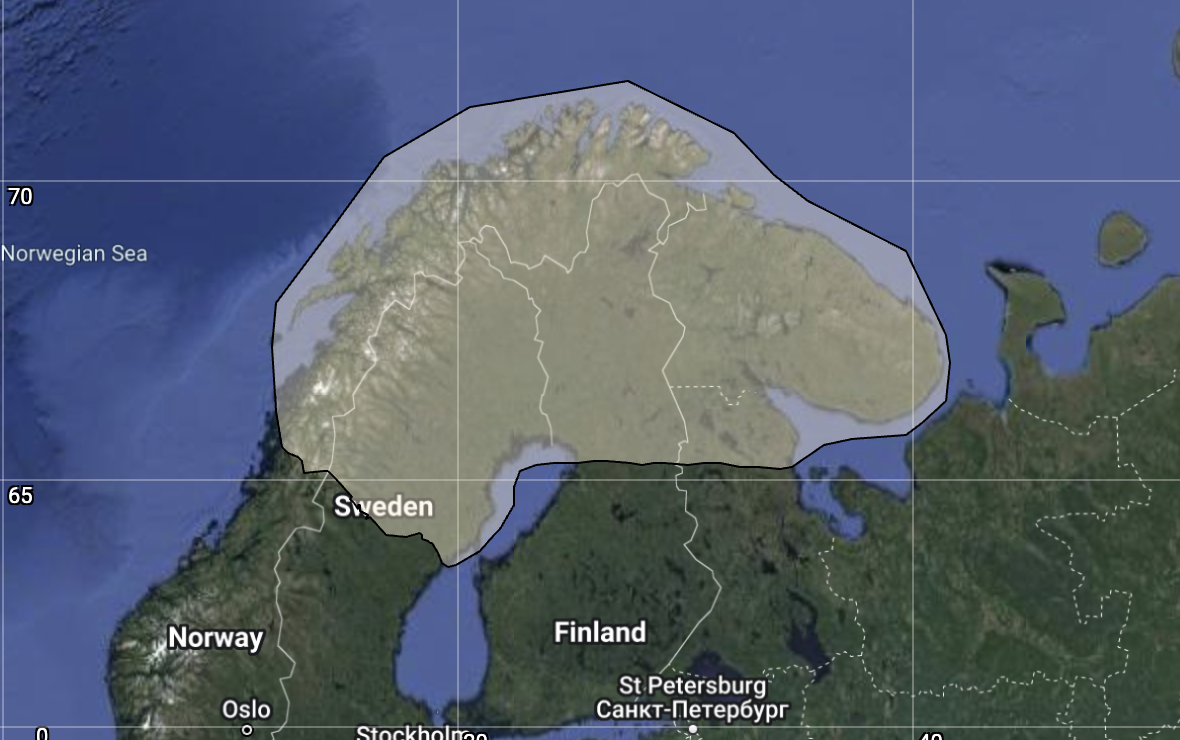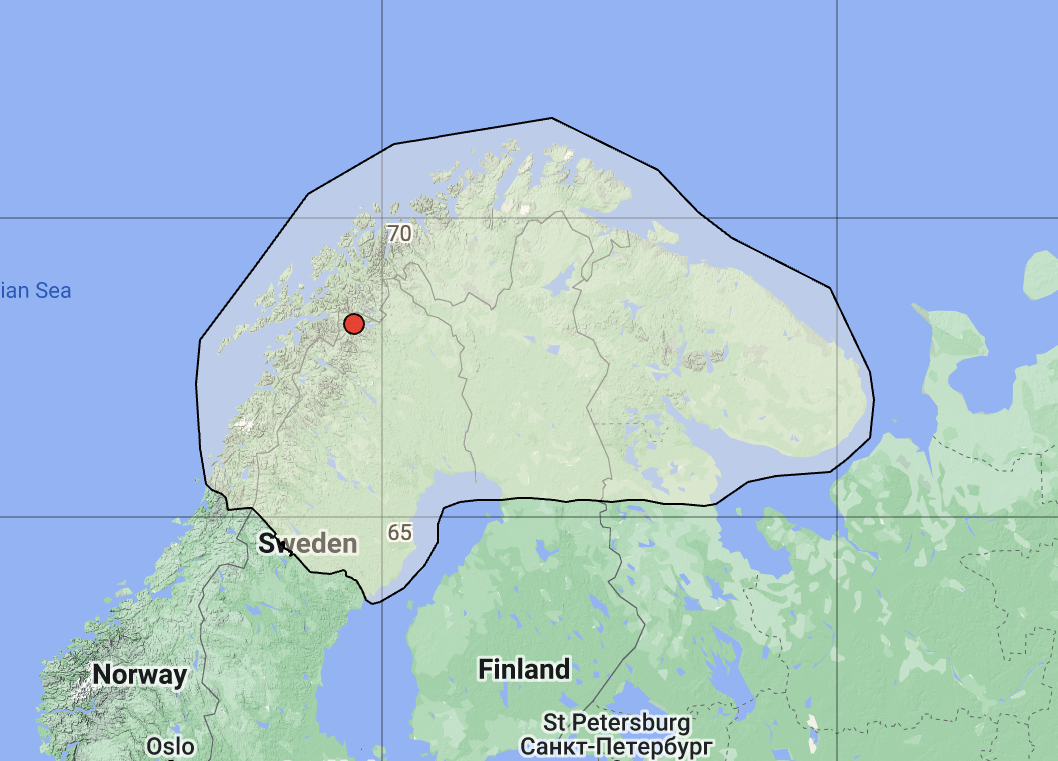Tsumiyoku

Tsumiyoku
As of July, 2024
Tsumiyoku [ Old Tsumiyokian : Tojommiyoku /tojomˈmiʝoku/; American English : /t͡ʃʊmiˈjoʊkuː/ ([sumiˈjoʊkʰu] or [sʊwmɪjˈjoʊkʰʊw]) ], officially The Tsumiyokian Federation, is a country in northern Europe, located in Lapland between Sweden, Norway, Russia and Finland.
| Government | Federal Parliamentary Republic |
|---|---|
| President of the Althing | Miyokutsu Clan |
| Capital | Edzhalpajoe (68°20'56.92" N, 18°48'50.08" E) |
| Official languages | No official language |
| Federal administrative language | Old Tsumiyokian |
| Recognized languages | Clanic languages: Tsumiyoki, Sami,... |
| Total Area | 566,584.29 km² (49th) |
| Population | ... |
| Demonym(s) | Tsumiyokian |
| Currency | Tilu |
| Time zone | UTC+2 |
| Internet TLD | .ts |
| Code ISO-3166 | TSU, TU |
| Calling code | +304 |
Tsumiyokian Territories:

Flag of Tsumiyoku:

Summary
History
The exact origins of the Tsumiyokien people are difficult to determine. We can only guess the places and dates present in the oral tradition of these people.
The “proto-tsumiyokiens” begin their history in what would seem to be the current Zagros mountains (Iran), during the Würm glaciation. Little is known due to the current lack of archaeological evidence, and possibly distorted oral tradition over time. The end of the Würm glaciation, which began as early as 12000 BC and ended around-9500 BC (freeing of paths to the north and warming of the south), and the gradual development of the populations surrounding the mountains (Semitic, fertile crescent, valley of the 'indus, etc) are probably reasons that pushed the proto-tsumiyokians to leave the Zagros mountains around 8000 BC. It should be added that according to oral tradition references and the DNA comparisons carried out on the various tsumiyokiens populations, the appearance of the proto-tsumiyokiens had probably already started to diverge, which could have constituted a breeding ground for conflicts with the surrounding populations.
The proto-tsumiyokiens therefore migrated around 8000 BC, rather quickly, to the plateaus of central Siberia. Their stay on these plateaus only lasts a rather short period of time, around 2000 years, but has contributed significantly to the traditions and culture of the various Tsumiyokian peoples, being their foundation. The proto-tsumiyokiens lived between tundra and taiga according to the rhythm of the seasons on these plateaus, being attached to both the plains and the forests.
Around 6000 BC, as the climate cools, it is more difficult to live, hunt and gather, which is the probable cause of the departure of the proto-tsumiyokiens. This event is also considered the transition from proto-tsumiyokians to “middle” tsumiyokians. This period is better documented due to a much less myth-based, oral tradition, and due to the presence of early archaeological artifacts.
The tsumiyokians first descended towards the surroundings of Lake Baikal then went westward along the Altai mountains and the steppes of Central Asia, until arriving at the south of the Ural mountains around 5000 BC. These mountains are more fertile and wooded, therefore more welcoming. This development is probably linked to the beginnings of agriculture (the tsumiyokians remain semi-nomadic, however) and to the beginnings of an oral literature conveyed by people equivalent to troubadours. The isolation in which the tsumiyokians lived at this time probably completed the entrenchment of the biological traits that we know them to have. At that time the families that will compose the Miyokutsu clan, began to impose themselves by developing and improving the tsumiyokian lifestyle. They would indeed have undertaken various trips to the south, east and west and would have brought back with them and then developed various technologies, including agriculture, metallurgy, shipbuilding or even genetically selecting plants and animals that were best adapted the conditions of the Ural Mountains.
The reason for the departure of the tsumiyokians from the foothills of the Urals is not precisely determined, there may be multiple external variables as well as an ideology of finding the "motherland" (in the collective memory it is about the plateaus of Central Siberia). However, if this hypothesis is true, the vagueness left in the oral traditions as to the direction of arrival of the tsumiyokians at the foot of the Urals would explain their departure towards the north, believing they were following the mountains (Urals instead of Altai), seeing the sea (Caspian instead of lake Baikal) and thinking of returning to the ancestral plateaus of the north. This departure would have taken place around 4000 BC, and is at the origin of the arrival of the tsumiyokians in their current place of residence, Lapland. Due to the archaeological remains found in Lapland and at the foot of the Ural Mountains, there is reason to think that this migration was rapid (a few months, less than ten years according to the highest estimates) or even that the tsumiyokiens kept for a few years a link between Lapland and the foot of the Ural Mountains. This migration also participated in confirming the political dominance of the Miyokutsu clan, indeed it disclosed the hitherto secret technology to the other tsumiyokiens of shipbuilding and navigation, allowing the tsumiyokiens to cross the white sea from the surroundings from the village of Shoyna in the Nenets Autonomous Republic, in modern Russia. The Tsumiyokians first landed around [insert location1] and gradually colonized present-day Tsumiyoku. Until then the tsumiyokiens spoke a common language, which had varieties specific to the clans but very largely intelligible. From the arrival in Tsumiyoku followed by the complete and definitive endorsement of the clan system, the Tsumiyokian language was divided into clan daughter languages. Thus, to refer to the still unified language spoken at the time of the landing at [location1], we speak of Old Tsumiyokien.
With the Finnish populations settling more or less at the same time as the Tsumiyokians in the north, a period of uncertainty takes place during which the two peoples live almost in cohabitation in the southernmost part of Lapland, until little by little the clans asserted themselves and “drew” the borders. On the other hand, relations with the Finns remain cordial and result in commercial exchanges. The arrival of the Sami, a Finno-Ugric population in Lapland pushed by the Finns towards the north from 2000 BC generated a period of hostilities of about a century and a half marked by several armed conflicts, the most important of which is the battle of [ battle 1] won by the tsumiyokiens around 1732 BC. This battle was ended by a peace treaty favorable to all parties. Indeed, the reaction of the tsumiyokiens being only purely defensive, although marked by the fear of a newcomer, they proposed to integrate and represent the Saami tribes/clans within the Althing. At first, the Saami clans have more of what can be likened to an observer status and the right to defend their interests, while the Tsumiyokian clans have a voice in discussing and debating the good of the country and the different peoples as a whole. The peace treaty therefore marks tolerance towards the Saami and recognition of their culture and way of life in exchange for integration into the Tsumiyokian political entity. {indicate cultural and linguistic borrowings}
The arrival of the proto-Germanic people from 180 BC is marked by rather peaceful trade relations, although they are only episodic due to the non-proximity of the borders of the two peoples. Scandinavian Vikings try to go up the Atlantic coast from 670 AC but are quickly repelled by the tsumiyokiens. The latter did not kill the former but only showed the Scandinavian forces their power, dissuading them from colonizing northern Scandinavia and definitively settling Scandinavian-Tsumiyokian relations through trade and cultural exchanges. {indicate cultural and linguistic borrowings}
During the 12th century, the Karelian tribes started to form alliances and began to be annexed in the territories of the Republic of Novgorod while the Finnish tribes were integrated under the crown of Sweden. During this period, several conflicts took place between the Tsumiyokien clans and the kingdom of Sweden as well as the republic of Novgorod, which leads to the formation of the modern Althing to allow the Tsumiyokiens clans to better respond to external dangers, the Miyokutsu clan, which was already the most dominant clan, whether culturally, economically or technologically, is appointed leader of the Althing giving it command of the unified Tsumiyokian army and taking a neutral mediating role within the Althing. This is considered the formation of the Tsumiyokian Confederation, the first real Tsumiyokian state, in [insert date 1].
In [insert date 2], the treaty of [insert place 2] is signed which demarcates the border between the territories of the confederation and those of the kingdoms of Sweden and Norway, being in personal union, and recognizes the sovereignty of the crown Swedish over the Finnish tribes, while allowing trade between these tribes and the confederacy.
In [insert date 3], the Treaty of [insert place 3] is signed which demarcates the border between the territories of the confederation and those of the Novgorod Republic and recognizes the sovereignty of the Novgorod Republic over the Karelian tribes, while allowing trade between these tribes and the confederacy.
In 1323, the Treaty of Nöteborg was signed between the Kingdoms of Norway, Sweden, the Republic of Novgorod and the Tsumiyokian Confederation, which replaced the treaties of [places 2] and [places 3]. This treaty defines the borders between the signatory countries and authorizes trade between their merchants.
In 1478 the Republic of Novgorod was unified with the Grand Principality of Moscow, but the Grand Principality of Moscow reaffirmed the validity of the Treaty of Nöteborg.
Between 1700 and 1713, the Great Northern War ravaged the lands between the 4 powers of the region, the Empire of Russia, the Kingdom of Sweden, the Tsumiyokian Confederation and the Polish–Lithuanian Commonwealth, and even involved the Kingdom of Denmark, the Grand Elector of Saxony as well as the Ottoman Empire. Despite many victories early in the war, and a temporary subjugation of the Tsumiyokian Confederacy and the Polish–Lithuanian Commonwealth, the Kingdom of Sweden lost the war.
During this war, the Tsumiyokian Confederation was almost completely defeated, but with the arrival at the head of the Miyokutsu clan of two new and talented heads of clan, the Miyokutsu clan managed to repel the Swedish army and recapture the occupied territories, they then consolidate the Tsumiyokian Confederation, which over time has been more and more centralized, in the Tsumiyokian Federation, a federal parliamentary republic.
The Treaty of Nystad, signed in 1713, ended the Great Northern War, forcing Sweden to cede Ingria, Estonia, Livonia and southeastern Finland to Russia, except for the territories of Livonia south of the Daugava which were ceded to the Polish–Lithuanian Commonwealth, while the independence and neutrality of the Tsumiyokian Federation is recognized and guaranteed by all the signatories.
Taking a cue from the United States and revolutionary France, under the new heads of the Miyokutsu clan, officially established a constitution for the Tsumiyokian Federation, as well as the clan itself, in 1804. In the years which follow all the other clans adopt theirs.
In 1809, The Treaty of Fredrikshamn where Sweden recognized the annexation of Finland and the Åland Islands by Russia, Finland became an autonomous Grand Duchy of the Russian Empire, the Grand Duchy of Finland.
During the Russian Civil War, between 1917 and 1921, the Tsumiyokian Federation helped the Karelian and Finnish people to obtain their independence from Russia, after which very friendly relations were formed between the three countries, and trade flourished.
On November 30, 1939, the USSR began an invasion of Karelia and Finland, but the two countries, forming a united front, managed to resist the Soviet armies until 1940, after a reorganization. Thus the Tsumiyokian Federation was forced to intervene to maintain the territorial integrity of the two nations. Thanks to this intervention, the Soviet forces were pushed back, and the USSR was forced to sign the Treaty of Leningrad which ended the war without there being any exchange of territory, but which forced a promise of non-aggression on the part of the USSR towards the two countries. The USSR was also forced to pay reparations to the three countries. This war, which lasted 4 months, was nicknamed the Winter War due to it taking place between November 1939 and February 1940, it was also the last war fought in the region.
Political History
After the arrival of the Tsumiyoki people in modern Tsumiyoku, gradually, disputes and conflicts began to arise among different clans. This led to the division of the Tsumiyoki people into multiple factions, encompassing a significant portion of all existing clans. However, before this could erupt into war and permanently divide the Tsumiyoki people, the Miyokutsu clan, which had remained neutral despite being the most dominant clan long before the advent of modern Tsumiyoki, decided to unify the clans under its influence along with their allies. This faction advocated neutrality, peace, and unity. Subsequently, they gathered all the other clans in an assembly, the ancestor of the Althing, whose purpose was to resolve and arbitrate all conflicts between clans. To ensure the proper proceedings of this assembly, it was decided that at the beginning of each assembly, a clan would be elected as assembly leader, to serve as the guarantor of the assembly's neutrality, fairness, and order. This clan was, most of the time, the Miyokutsu clan, owing to its influence, integrity, status as the "founder" of the assembly, and its long history of assembly leaders who had served the Tsumiyoki people remarkably well.
With the passage of time and generations, the position of assembly leader became more than just a guarantor of neutrality, fairness, and assembly order; it also became responsible for implementing the assembly's decisions and took on the role of a ceremonial leader.
Following the crisis with the Sami and the formation of the Althing, the position of assembly leader became that of the Althing's president, encompassing the roles of commander-in-chief of the unified Tsumiyoki armies as well as the diplomatic representative of the Althing.
Over the course of centuries, the composition of the Althing has now begun to stabilize, along with the notion that the Miyokutsu clan was and will likely always be the chief of the Althing. Despite concentrating powers due to its neutrality and integrity, this was by no means something detrimental.
Geography
Federal capital of Tsumiyoku

The federal capital of Tsumiyoku is named Edzhalpajoe, which means "place of the Althing/parliament", and is located at the following coordinates: 68°20'56.92" N, 18°48'50.08" E
Economy
Due to its federal organization, Tsumiyokian clans may have very varied economies. The tsumiyokian clans constitute a federal free market.
Culture
Languages
Tsumiyoku, being composed of a multitude of clans, has numerous varying cultures and languages. Most languages descend from the Old Tsumiyokian language that was spoken at the time when Old Tsumiyokians came in modern Tsumiyoku. Other clanic languages include Sápmi languages, spoken by Sápmi clans and families. In addition Karelian, Finnish and Scandinavian (north germanic) languages are recognized as minority languages in some clans.